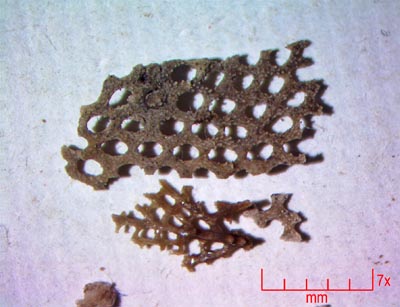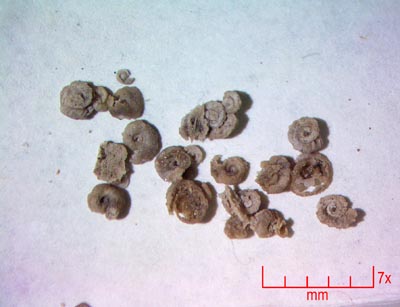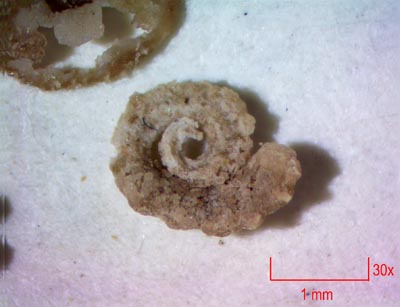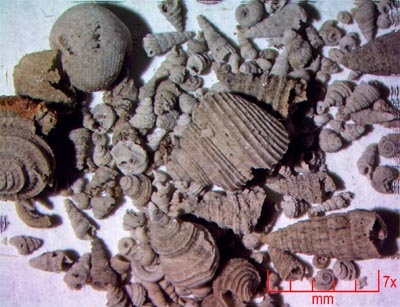|
We will be
eventually surveying the entire High line Trail outcrop in small
sections, bounded by visible landmarks in small short sections
up to 500 feet long. This first section is Site 1, and is the
first outcrop on the Sinkhole trail you come to going eastward,
about a quarter mile in. The fossils of each section are very
different and the preservation was seen to vary considerably.
This series of surveys are intended to gather a specific amount
of material (2 one gallon zip lock bags) from each section, and
report the findings here from the acid bath fines. Site 1 is
also variable in content across its span. The west end is dominated
by bryozoans and ostracods. The east end is far more fossiliferous
and has few bryozoans but loads of tiny gastropods, juvenile
scaphopods, and sponges. Larger pieces of trilobites start to
appear here.
Now the reason
I am posting the location of this locality is to bring other
micro fossil collectors to this very unique world class site.
Dont bother coming here if your not ready to spend hours dissolving
limestone in muriatic acid, and spending countless hours searching
through the acid fines under a stereo microscope to find your
quarry! This is not a site where you can just pick up fossils
off the ground. It is for the dedicated micro fossil sleuth to
make new exciting discoveries. If you are interested in this
type of work, or just curious what fauna we found at this amazing
site - Read on...
NOTE: Click all
images to get the larger 1290 x 960 sized image.

|
The
authors set up includes a quality binocular microscope (Amscope),
sorting trays and vials, a strong white LED light source and
of course my helper cat Rory. |
Bryozoans

|
We
find two types of bryozoans in the Fort Apache Limestone. This
one, a small branching type with very tiny pores dominated the
fauna at the west end (zone 1) of the Site 1 outcrop. They are
very delicate and care must be used when picking up the small
branches. |

|
The
second type of bryozoan found here is the Fenestrate types. These
originally fan shaped organisms were anchored to the sea bottom
and hosted a colony of literally millions of zooids in their
fans. Two types are shown here. |

|
Close
up of the specimen on the bottom in the above image. Note the
webbing is smooth between holes. |

|
The
dominant type is this bryozoan. Small pockets in the protrusions
between holes held the tiny animals, which spread out feeding
arms to capture plankton for food. |
Chonetids

|
Tube
worms are everywhere in the Fort Apache. They are found singly
as seen here as they fell off the vegetation when the plant dies.
Also they are found covering all sorts of other organisms including
urchins, gastropods, corals and anything they can cement their
tests to. Two of them on the right are a different species with
ridges along their whorls. |

|
Chonetid
with whorls. |

|
Normal
Chonetid. The animal was an annellid worm which fed by extending
outside their home and grabbed plankton. |
Mollusks

|
The
most common pelecypods found are the Astartella subquandrata.
Small but very detailed, they are the dominant clam. |

|
Permorphorus
sp. are box shaped and we only found these three in the two gallons
of rock. |

|
Rare
and beautiful, Parallelodon anaklassium is a magnificent tiny
clam with a wing like appendage along the hinge. |

|
Bakevellia
sulcata. This unusual mollusk was pretty common in other sites
finds, and seen here are two different modes of preservation. |
Rugose
Corals

|
Lophamplexus
sp. The crenelations on the exterior are diagnostic. Two specimens
are shown here. The lowermost was quite crushed by the weight
of the overlying sediment during diagenesis. |

|
End
on view of the calice showing a chonetid made its home inside
the vacant chamber after the coral had died. You can also see
the partitions (septae) inside. |

|
A
smaller coral of the same species. This is very uncommon - to
find TWO rugose corals in such a small sample of rock. We only
found one in past surveys after going through hundreds of pounds
of limestone! |
Crinoids

|
Crinoid
ossicles are are rare. These stem sections range in shape from
round to star shaped and offer a glimpse into the diversity present
in the Fort Apache Sea. |
Gastropods

|
Gastropods
are the main faunal element in the Fort Apache fossils. Numerous
species are seen here. An in depth identification of each type
found from Winters monograph can be found here. |

|
The
superb preservation of very small gastropods can be appreciated
in this shot of a penny with four small gastropods in this image.
They are so well preserved in many cases, the cavity inside is
hollow as in life. |
Cephalopods

|
Orthocone
nautiloids. Most likely cf. Psudorothoceras knoxense. Surprising
that we found two speciemens in two different rocks from such
a small sampling. The septa can be seen quite clearly in the
lower specimen. |
Ostracods

|
Two
genus of ostracods are found commonly in the Fort Apache. One
type is a simple clam-shell type anatomy and the other are the
hollowed out halves of a more complex ear shaped ostracod. Note
the yellow straw colored silica that they are preserved with.
This is the same as we find in the trilobites preserved. After
all, they are all arthropods. |
Scaphapods

|
Hordes
of scaphopods and thier juvinile teleoconchs were found. These
are mostly Plgioglypta canna, and the banded smaller ones are
thier teleoconchs. |
Stellate
Sponges

|
Occasionally
we find these magnificent tiny sponges that appear to radiate
from a single attachment. The osculum is well preserved here,
and as you can see from the scale, these are quite small indeed! |
Straparollus
Gastropods

|
The
juvinile straparollus gastropods seen here have not yet developed
the ribbing and grooves along thier sides. As they grow to around
half an inch in size, these features appear and then dominate.
Preservation here is amazing. not only can the tiny protoconch
(the embryo hatches in a small round shell in the middle) in
the very center of the whorls be seen clearly, but the ends of
the shell are open and hollow inside. |
Trilobites

|
Typical
finds include all one species. These are the frontal rim around
the crandidium and a few pieces of a free cheek. The color of
the silica is diagnostic. All the trilobites preserve this color
as do the ostracods. |

|
Free
cheeks including the eye cut out. The trilobites are Phillipsia
sp. and are not the same as found in the later Kaibab formation
that overlies on the Rim. |

|
For
the first time we have found thorax sections. This clearly identifies
the trilobite as Phillipsia sp. They are not Ameura or Ditamopege
found in the Kaibab. |

|
More
frontal rims from the crandium. |

|
Heres
a rare find - a set of ribs from the thorax floating in the fines!
They are usually so delicate they break apart. |
Echinoids

|
Small
pea sized to marble sizeed sea urchins lurked amongst the other
faunal elements in the Fort Apache Sea. We find many dissarticulated
urchin tests and spines in the mix, dominated by the spiny short
spines for the larger sizes and smooth stubby ones for the smaller.
Spine tubercles, water vascular apertures are common. |

|
These
are the water vascular system openings that reside on the top
of the Enchinoderm. They form a ring around the top and let water
in to move the tube feet below. |

|
Smooth
stubby spine types were commonly found at the zone 2 - East end
location. |

|
Spine
tubercle which is the mounting joint for the spines on the test
of the Urchin. |

|
Rarely
found, this is also located on the top of the urchin and disposed
of waste material. |
Sand,
minerals, crystals

|
There
is a great deal of terriginous sediments in the Fort Apache Limestone.
Most pieces we dissolved in the acid were 10 - 20 % dirt and
clays. This for the most part is washed out since it is much
finer than the fossils. Occasionally, larger sand grains can
be found in the fines from the smalles sieve we use. We find
quartz crystals, pink sand grains, yellow citrine, and a new
find this time - Metallic grains. |

|
Remember
that these are barely larger than a grain of sand. At the top
is a layered chert, center a gorgous crystal of mica. Below it
biotite mica probably from granite host rock on the shoreline
many miles distant. On the bottom is one of the metal grains,
most likely a manganese mineral. We find large pieces of manganese
in the overlying Kaibab. |

|
Highest
magnification with the stereo microscope on the mica crystal. |

|
Quartz
sand. Clear, citrine yellow, and rose quartz. |

|
Metallic
particles found amongst and within many of the fossils. The larger
piece is actually wrapped around a sand grain. Reminds me of
galena, molybdinite or manganese. |

|
Highest
magnification for the metallic particles. You can see the metal
crystals wrapping around a sand grain. |
Larger
sponges

|
Larger
macro fossils were also showing up in the acid fines. A larger
quarter inch screen is used to get the big rocks and larger fossils
out first, then we go finer after that with a good washing in
between. These are calcareous sponges that have silicified. The
scale in back is in 1 cm increments. |
Productid
Brachiopods\

|
Productus
sp. Same as in Kaibab formation. Out of the acid the spines are
found in some cases still attached as seen here. |
Larger
Scaphapods

|
Large
Plagyoglypta sp. Scaphapod. |
|










































